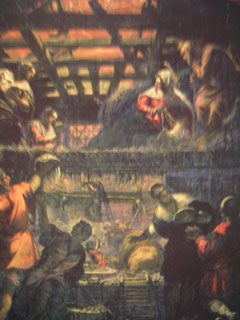For the Sunday before Christmas, this week’s picture is The Adoration of the Shepherds, by the great Venetian painter Jacopo Robusti, alias Tintoretto. It was painted between 1577 and 1581 for the Upper Hall of the Scuola di San Rocco in Venice, where it can still be seen together with a multitude of other paintings by the same artist on themes drawn from both Old and New Testament.
Many of the picture’s emphases and even the style in which it was painted are intimately related to the context for which it was created. The Venetian scuole were institutions which played a fundamental role in the religious life of the city as well as administering much of what we would now describe as its social services. They were devotional confraternities, each one dedicated to a different saint – the Scuola di San Rocco was dedicated to the French saint, Saint Roche, patron of plague victims – and centred on a particular building in the city. They accepted both rich and poor into their memberships, one of their functions being to redistribute wealth to those most in need of financial support. Poorer members might earn themselves alms, for example, by taking part in the funeral processions of their richer counterparts.
This powerfully communal ethos is touchingly expressed in Tintoretto’s Nativity for the Scuola di San Rocco, which was one of the most prominent of the Venetian scuole. The setting is a two-tier stable, a pictorial innovation which permits the artist among other things to include rather more of a crowd than is usual at the scene of Christ’s birthplace. On the lower level, shepherds and their wives bear in baskets of provisions and plates of food, which they hand up eagerly to sustain Mary and Joseph after their long...


